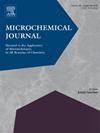抗癌药物 ribociclib-DNA 相互作用的首次伏安研究、分光光度法和分子对接研究以及一次性铅笔石墨传感器的分析应用
IF 4.9
2区 化学
Q1 CHEMISTRY, ANALYTICAL
引用次数: 0
摘要
Ribociclib(RIB)是一种用于治疗乳腺癌的细胞周期蛋白依赖性激酶抑制剂。本研究首次采用伏安法、分光光度法和分子对接技术对 RIB 与 DNA 的电化学行为、定量和相互作用进行了研究。研究使用了环保型一次性铅笔石墨电极(PGE)传感器作为工作电极。利用循环伏安技术,RIB 在 PGE 表面产生了 +0.837 V 左右的不可逆阳极波和 +0.278 V/+0.209 V 左右的可逆信号。使用 PGE 传感器,RIB 化合物在 PBS(pH 值 3.0)中的电位为 +0.77 V 时会产生非常明显的阳极信号。对于该分析信号,在 PBS(pH 3.0)中 0.0139 3 M-0.0973 3 M 的浓度范围内,RIB 的检出限和定量限分别为 2.84 nM 和 9.46 nM。通过伏安法、分光光度法和分子对接技术研究了 RIB 与 DNA 的相互作用。在对所有三种技术得出的结果进行评估后,确定 RIB 分子与 DNA 的相互作用是通过小沟结合发生的。本文章由计算机程序翻译,如有差异,请以英文原文为准。
First voltammetric studies, spectrophotometric and molecular docking investigations of the interaction of an anticancer drug ribociclib-DNA and analytical applications of disposable pencil graphite sensor
Ribociclib (RIB) is a cyclin-dependent kinase inhibitor used in the treatment of breast cancer. In this study, for the first time, the electrochemical behavior, quantification and interaction of RIB with DNA were carried out using voltammetric, spectrophotometric and molecular docking techniques. An environmentally-friendly disposable pencil graphite electrode (PGE) sensor was used as the working electrode. Utilizing the cyclic voltammetry technique, RIB produced an irreversible anodic wave around +0.837 V and reversible signals around +0.278 V/+0.209 V on the PGE surface. Using the PGE sensor, the RIB compound gave a very distinct anodic signal at a potential of +0.77 V in PBS (pH 3.0). For this analytical signal, the limit of detection and limit of quantitation values of RIB in the concentration range of 0.0139 3 M–0.0973 3 M in PBS (pH 3.0) were determined as 2.84 nM and 9.46 nM, respectively. The interaction of RIB with DNA was studied by voltammetric, spectrophotometric and molecular docking techniques. In the evaluation of the results obtained with all three techniques, the interaction of the RIB molecule with DNA was determined to occur through minor groove binding.
求助全文
通过发布文献求助,成功后即可免费获取论文全文。
去求助
来源期刊

Microchemical Journal
化学-分析化学
CiteScore
8.70
自引率
8.30%
发文量
1131
审稿时长
1.9 months
期刊介绍:
The Microchemical Journal is a peer reviewed journal devoted to all aspects and phases of analytical chemistry and chemical analysis. The Microchemical Journal publishes articles which are at the forefront of modern analytical chemistry and cover innovations in the techniques to the finest possible limits. This includes fundamental aspects, instrumentation, new developments, innovative and novel methods and applications including environmental and clinical field.
Traditional classical analytical methods such as spectrophotometry and titrimetry as well as established instrumentation methods such as flame and graphite furnace atomic absorption spectrometry, gas chromatography, and modified glassy or carbon electrode electrochemical methods will be considered, provided they show significant improvements and novelty compared to the established methods.
 求助内容:
求助内容: 应助结果提醒方式:
应助结果提醒方式:


